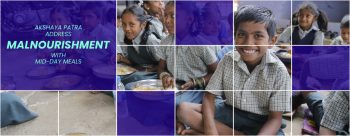It would be natural to assume that after all the freshly cooked food has been packed into steel containers most of the work in the kitchen is done. But as Mallesh H.K., Loading Supervisor explains, this is not the case. Our Hubli facility has 35 food vans travelling on specific routes around the Hubli-Dharwad region, each one distributing food to an average 22 schools per route. Determining the number of containers and amount of food that each school along a route needs, is one of the challenges Mallesh must address everyday. The containers need to be packed to optimise time spent at every stop, because with so many schools to be covered, each van has little time to waste when they arrive at the schools.
Mallesh underwent one week of training which included on route travel as well as kitchen work and then worked for a year on routes before becoming a loading supervisor.
“Our route supervisors collect information from every school about how much food we should deliver for the next day, based on approximately how many children will be attending. They fill in a form which contains all the schools in the route and the projected number of containers of food each school needs. This is then consolidated into a separate sheet for all routes,” he says pointing to a sheet which contains details such as the number of schools per route, the total quantity of rice, sambar, curd or sweet that is required (depending on the menu for the day).
Written in the rows of a consolidated tracking sheet are the names of each route around the Hubli-Dharwad region. Its columns represent the quantity and type of food. “If there is 25 written in the column headed 50% under ‘Rice/Palav‘ on a row containing the name ‘Mugad’, we’ll know that for the Mugad route in the Hubli-Dharwad area, a food van must have a total of 25 steel containers packed only to 50% capacity of rice or palav,” he explains. The containers come in large, small and medium sizes, he adds and all of them will have been labeled the previous evening with a corresponding route name and required quantity.
The loading and distribution processes have been perfected over time, says Yagneswar Das, who heads the entire operations of the facility. They recently optimised the number of routes needed to cover all schools, bringing it down from 38 to 35. “We all got together and decided to make it more efficient,” he says. “The route optimisation was done by us, in-house,” he says. We use optimisation techniques not just in distribution, but also in the actual cooking processes to reduce costs. Akshaya Patra’s all India cost for one meal is just Rs. 6. Today, for every rupee donated to the Foundation, 9 paisa is spent on administrative costs.
Mallesh and his team work diligently everyday, adhering to a strict schedule to ensure food vans leave on time. When their day is over, they will have loaded a total of 5000 containers into all 35 vans.







